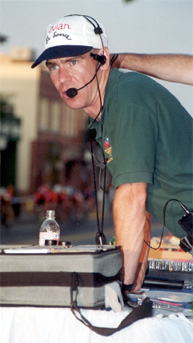By Tom Demerly for tomdemerly.com

As a commentator, he was a master. Measured. Well-paced. Gifted with dramatic inflection and a lilting accent that brought credibility to his narration. As a dramatist, he was a rare thespian of the microphone. He paced his voice, volume and inflection to build a crescendo that hammered on the edge of control. And perhaps most importantly, as a person, he humanized and dignified a sport that is rife with indignity and subterfuge.
Paul Sherwen died last week at the age of 62. Far too soon. His untimely passing is gutting to the world of cycling, not just for fans who loved him, but for the complex synergy of broadcasting the Tour de France and all of professional cycling in the English language.
You can read of Sherwen’s impressive professional cycling career in any of the many eulogies published around the world for him over the last 72 hours. But Sherwen rose to greatest prominence as a broadcaster, commentator and even moderator of cycling’s most turbulent era.
Sherwen began broadcasting with Phil Liggett in 1989. That is when he went from great cyclist to mega-star. The combination of Phil Liggett and Paul Sherwen was not just good, it was magical synergy. The sum was greater than the total of its parts. By themselves, Sherwen and Liggett were excellent commentators. Together they became the institution of cycling in the English language.
It would not be an embellishment to suggest the team of Sherwen and Liggett saved cycling.
The damage inflicted by the Armstrong era cast a dark cloud over professional bike racing and the Tour de France. Its creditability as a legitimate sport was shattered in the post-Armstrong era and didn’t recover even after the brash Texan doper and extortionist was forced into exile. The doping scandals and accusations continued. For any informed observer, cycling had a titanic image problem. It was dirty.
Enter Paul Sherwen and Phil Liggett. Commentating next to the thousand-pound doping elephant in the room the duo would chat during slow stages as the group rode together at a pedestrian pace. Cycling coverage had changed from a 45-minute recorded and scripted highlight reel to a rolling commentary of the entire stage. It became an endurance event for live announcers. Try describing anything non-stop for six hours. If your voice holds, you quickly find out you run out of things to say. Not Sherwen.
During the Tour de France, Sherwen and Liggett were served snippets about the areas the riders were passing through from race organizers. They were dry historical facts about castles, bridges, rivers and factories. It was the stuff you slept through in school. But Sherwen would grab this stuff off the feed and, as though you were sitting next to him in a touring sedan on a leisurely drive across rural France, weave a lilting tale from the popcorn-dry feed. When Sherwen talked about the milk production of the cows of Provence region, it sounded quaint and charming and… damn near interesting.
When the action started, Sherwen’s voice moved to his gut. He became more baritone. More Serious. More urgent. His pace picked up just a tick. Tension boiled under his narration. It felt as if the other shoe would drop at any moment, and we all slid to the edge of seats. His colloquialisms were Shakespearean. Who had ever heard what it was like to, “Throw a cat among the pigeons” or, “Reach deep into the suitcase of courage” before Paul Sherwen? Sherwin brought rare dramatic eloquence to a sport of blue collar schoolboys.
Paul Sherwen dignified cycling, amplified the drama, downplayed the scandal.
It is difficult to imagine a post-Sherwen cycling era. At 75 years old, Phil Liggett may decide to pack up his microphone and move on to a well-earned retirement. Something Paul Sherwen never got. Sherwen played the key role to Liggett’s performance, shoring him up when he made the errors in remembering a cyclist’s name that any 75-year old would make. They did so seamlessly, and it only added to the show. But without Sherwen as his muse and protector, Liggett may not want to continue. If that is the case, it is not too much of a stretch to say that when we lost Paul Sherwen, we lost all of cycling. Or at least any semblance of dignity, drama and decency it had left.

Tom Demerly has been a cycling commentator and journalist for over 30 years. He has written for Outside, Velo-News, Inside Triathlon, Triathlon Today, Triathlete, Bicycling, Bicycle Guide, USA Cycling, USA Triathlon and many others.



















